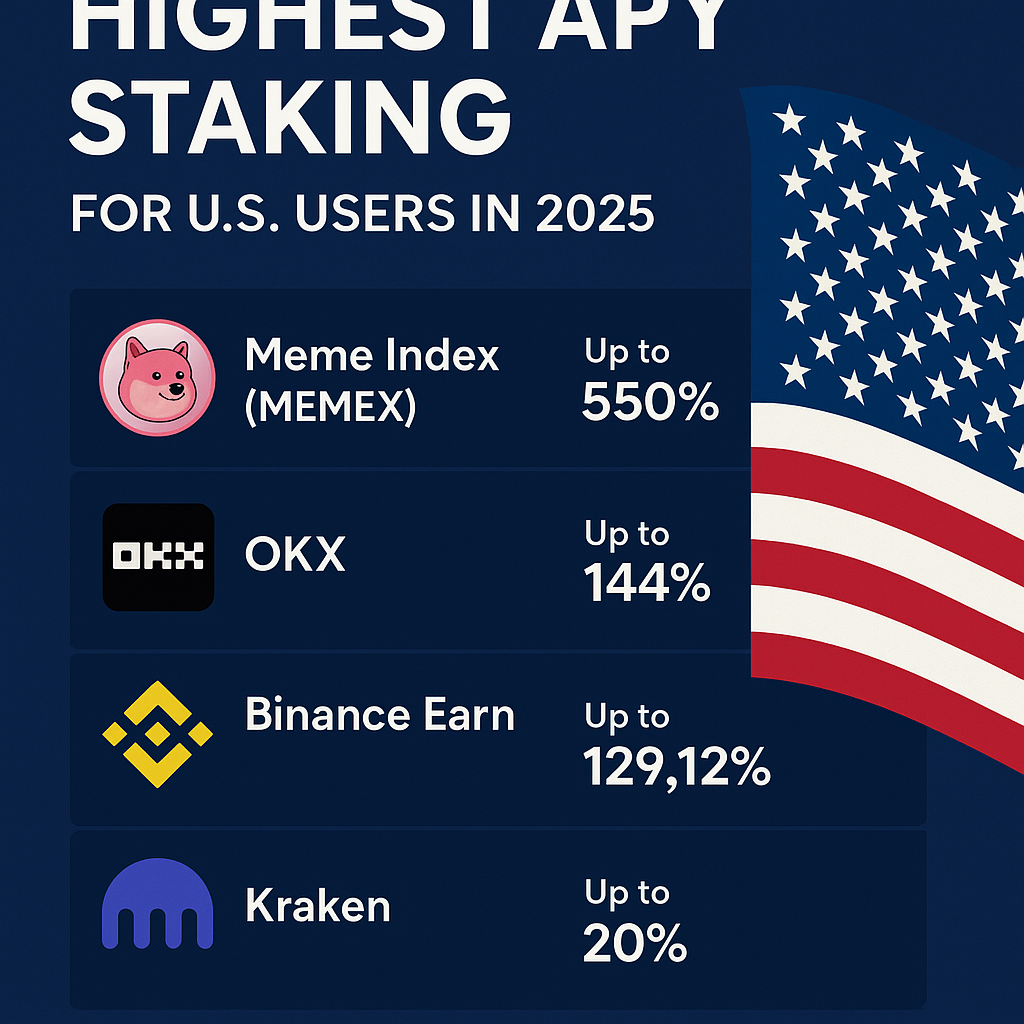Highest APY Staking for U.S. Users in 2025
By Abhishek Chandravanshi

In 2025, U.S. crypto holders are more eager than ever to earn passive income from their long-term digital asset holdings. With traditional savings accounts offering yields of barely 1–2%, staking crypto has become a much more attractive option—often paying 10x higher rates or more.
But with evolving U.S. regulations and the recent shake-up in centralized staking platforms, it’s not always clear where Americans can still stake crypto safely—and profitably.
In this detailed guide, you’ll discover:
The highest APY staking opportunities for U.S. users
The best platforms (centralized & decentralized)
A comparison of staking rates by coin
The safest and most flexible options for 2025
Tips to boost your yield and manage staking taxes
Let’s dive in.
🔍 What Is Staking and How Does It Work?
Crypto staking is the process of locking up your tokens in a blockchain network (usually proof-of-stake or PoS) to help validate transactions and maintain the network’s integrity. In return, you earn rewards—typically paid in the same token.
The more tokens you stake, and the longer you hold them, the more you typically earn. The annual return is expressed as APY (Annual Percentage Yield)—which includes the effects of compounding.
For example, staking 1,000 DOT at a 14% APY could yield you about 149 DOT after one year, if compounded daily.
Different networks and platforms offer different APYs, and it’s not always easy to compare them. That’s why we’ve done the hard work for you.
🚀 Top 5 Platforms Offering the Highest Staking APY for U.S. Users (2025)
1. Kraken
Max APY: 22% (for DOT, ATOM)
Supported Assets: ETH, DOT, ATOM, ADA, KAVA, XTZ, FLOW, MINA
Custodial: Yes
Lock-Up Period: Varies (some flexible, some fixed)
Fees: Built into reward rate
U.S. Access: ✅ Available in most states except NY
Best For: High yields on major PoS assets with a trusted brand
Kraken remains one of the few U.S.-compliant exchanges still offering staking as of 2025. With transparent APYs and a user-friendly interface, it’s ideal for both beginners and experienced stakers.
2. Coinbase
Max APY: 6% (ATOM), ~3.5% (ETH)
Assets: ETH, ALGO, XTZ, ATOM, SOL
Custodial: Yes
Lock-Up: Yes, depending on asset
U.S. Access: ✅ Nationwide
Notes: One of the most compliant and user-friendly options
Coinbase simplifies the staking process and offers direct staking for ETH, SOL, and others. Though APYs are lower than DeFi options, Coinbase’s ease of use and regulatory compliance make it a solid choice for passive earners.
3. Lido Finance (via Wallets)
Max APY: ~4.3% (ETH)
Assets: ETH, SOL, DOT (depending on integrations)
Custodial: No (non-custodial via wallets like MetaMask)
Lock-Up: No lock (liquid staking)
U.S. Access: ✅ Open globally (use at your own risk)
Notes: Provides stETH, which you can use in DeFi while earning
Lido allows U.S. users to stake ETH and receive stETH in return—a token representing staked ETH that stays liquid. It’s ideal for those who want flexibility and access to DeFi protocols.
4. Rocket Pool
Max APY: ~4.5% (ETH)
Assets: ETH
Custodial: No
U.S. Access: ✅ Available via wallets
Unique Features: Decentralized node operation; community-based
Rocket Pool offers a more decentralized alternative to Lido. It’s a good choice for ETH holders who value decentralization and want to participate in a community-led staking infrastructure.
5. Binance.US (Check Availability)
Max APY: Up to 9% (SOL, ADA)
Assets: SOL, ADA, AVAX, MATIC, ATOM
Lock Period: Varies
U.S. Access: ✅ Only in eligible states
Note: Regulatory status is uncertain; always verify availability
Binance.US has scaled back its staking offerings due to regulatory pressure, but users in eligible states may still access competitive rates. Check their current terms before committing.
📈 Highest Paying Staking Coins in 2025
Here’s a breakdown of the top staking tokens based on current APYs and U.S. accessibility:
| Token | Est. APY | Best Platform | Notes |
|---|---|---|---|
| DOT | 12–22% | Kraken | High yield; long-term play |
| ATOM | 6–22% | Kraken, Coinbase | Strong returns with good liquidity |
| SOL | 6–9% | Kraken, Binance.US, Lido | Scalable and still popular |
| ETH | 3.5–4.5% | Coinbase, Lido, Rocket Pool | Most popular staking asset |
| ADA | 4–6% | Kraken, Binance.US | Low risk with stable return |
⚠️ Staking Risks and Considerations for U.S. Users
While staking can be lucrative, it’s not risk-free. Here are key concerns for U.S. users:
1. Regulatory Uncertainty
The SEC is still cracking down on some centralized staking services. While platforms like Kraken and Coinbase have adjusted, changes may come.
2. Lock-Up Risks
Some platforms require fixed lock-up periods. With ETH, for example, unstaking can take several days or weeks depending on network congestion.
3. Validator Risk / Slashing
Improper validator behavior can result in slashing—i.e., partial loss of your staked assets. This risk is more prevalent in decentralized staking.
4. Platform or Wallet Risk
Custodial platforms can freeze or lose funds. Non-custodial DeFi staking, on the other hand, requires technical knowledge and trust in smart contracts.
🧠 Tips to Maximize Your Staking Returns in 2025
Diversify Your Staking Portfolio Spread your assets across different coins and platforms to reduce platform risk and benefit from rate differences.
Use Liquid Staking Platforms like Lido let you earn while retaining liquidity—ideal if you want flexibility or to use your staked assets in DeFi.
Restake Manually (If Needed) Some platforms don’t auto-compound. Make sure to manually restake rewards to maximize returns.
Track Live APYs Rates change regularly. Use tools like the CryptoTrendd Live APY Tracker to keep up-to-date.
Understand the Tax Implications The IRS considers staking rewards as income. Use crypto tax software to record, report, and minimize tax headaches.
🧾 IRS Tax Rules for Staking in the U.S.
In 2025, staking income must be reported as ordinary income at the time it’s received. That includes:
Rewards from ETH staking (even liquid tokens like stETH)
Rewards automatically added to your balance
Be sure to:
Keep detailed records of staking dates and reward values
Use tax tools like Koinly, CoinLedger, or TokenTax
File staking income under “Other Income” if doing taxes manually
❓ Frequently Asked Questions (FAQs)
Is staking crypto still legal in the U.S. in 2025?
Yes, but with stricter regulations. Centralized platforms like Kraken and Coinbase operate within legal boundaries. Some services like Binance.US are restricted in certain states.
Which crypto gives the highest staking return?
In 2025, Polkadot (DOT) and Cosmos (ATOM) offer some of the highest yields, going up to 22% APY on Kraken.
What’s the safest way to stake crypto in the U.S.?
For beginners, Coinbase or Kraken offer safety and simplicity. For advanced users, Lido and Rocket Pool provide decentralized, non-custodial options.
Is staking better than just holding crypto?
If you’re holding long-term, staking allows you to earn rewards rather than let coins sit idle. However, if you’re actively trading or need liquidity, holding may be better.
Can I lose money staking crypto?
Yes. Aside from market price drops, risks include validator slashing, lock-up restrictions, and platform failures.
✅ Final Verdict: Best Staking Strategy for U.S. Users in 2025
If you’re based in the U.S. and looking to stake crypto in 2025, you have multiple high-yield options—even in a tighter regulatory landscape.
For top returns and a trusted brand: Kraken is the leader.
For simplicity and security: Coinbase is unbeatable for beginners.
For decentralization and liquidity: Go with Lido or Rocket Pool.
If eligible in your state: Binance.US still offers strong APYs.
💡 Combine centralized and decentralized options, use APY tracking tools, and optimize your staking for both returns and safety.
👉 Track Live Staking Rates Now on CryptoTrendd
Related Reading:
